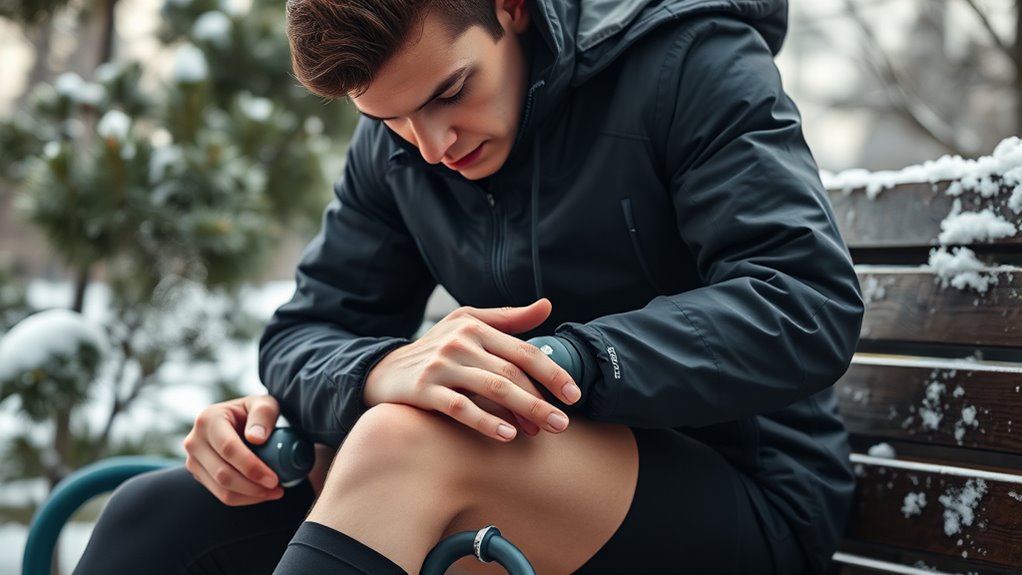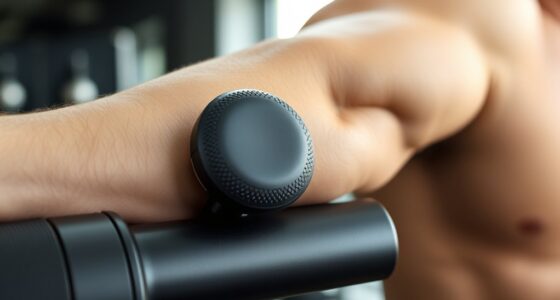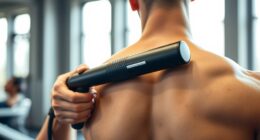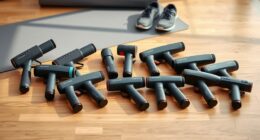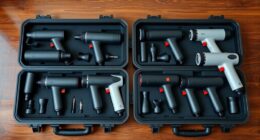In winter, muscle soreness often worsens due to cold-induced muscle tightening and slower circulation. Percussion therapy helps improve blood flow, relax tight muscles, and break up adhesions, making it an effective way to combat DOMS. To get the best results, warm up your muscles beforehand and wear proper gear during outdoor workouts. Keep exploring ways to stay comfortable and recover faster so you can enjoy your cold-weather workouts to the fullest.
Key Takeaways
- Percussion therapy boosts blood flow, delivering nutrients essential for muscle repair after cold-weather workouts.
- It relaxes tight, stiff muscles caused by cold-induced tightening, reducing soreness and discomfort.
- Applying percussion therapy after warming muscles enhances deep tissue penetration and improves flexibility.
- Combining percussion therapy with proper nutrition and outdoor gear optimizes recovery during winter.
- Regular use helps counteract winter-related muscle stiffness and accelerates recovery from DOMS.

Have you ever wondered why delayed onset muscle soreness (DOMS) seems worse during winter? The colder weather can amplify muscle pain after workouts, making recovery feel more challenging. One reason is that your muscles tighten up in response to the cold, increasing stiffness and discomfort. Plus, the reduced sunlight and lower temperatures can slow circulation, which hampers the delivery of nutrients needed for muscle repair. This is where recovery nutrition becomes essential. Consuming foods rich in protein, antioxidants, and anti-inflammatory compounds helps your muscles recover faster and reduces soreness. Incorporate sources like lean meats, berries, and leafy greens into your diet, especially after outdoor workouts, to support quicker healing. Hydration remains critical too; even in winter, staying well-hydrated flushes out toxins and keeps your muscles functioning smoothly. Additionally, embracing Inspirational Quotes About Fatherhood can motivate you to stay consistent with your winter training routine. When tackling DOMS in winter, having the right outdoor exercise gear makes a big difference. Layering moisture-wicking clothing keeps you warm without trapping sweat, which can lead to chills and muscle tightness. Insulated gloves and thermal leggings help maintain muscle warmth, preventing stiffness that worsens soreness. A good pair of waterproof, insulated shoes can keep your feet dry and warm, which is essential for maintaining proper circulation and reducing muscle tension. Wearing reflective gear is also smart, especially during shorter winter days, so you stay visible during outdoor workouts. When your muscles stay warm and loose, they’re less prone to injury and soreness, making recovery easier. Percussion therapy offers an effective way to manage DOMS, especially in cold weather when muscles tend to tighten more. Using a percussion massager on sore muscles increases blood flow, helping nutrients reach tissues faster and clearing out waste products that cause pain. It also relaxes tight muscles, reducing the discomfort associated with winter stiffness. The rhythmic taps penetrate deep into muscle tissue, breaking up adhesions and encouraging flexibility. This therapy can be easily integrated into your post-workout routine, particularly when outdoor conditions make traditional stretching less comfortable. Just make sure your muscles are warmed up beforehand, either with light activity or by using your outdoor exercise gear to maintain warmth, to maximize percussion therapy’s benefits. In winter, managing DOMS requires a combination of proper recovery nutrition, suitable outdoor gear, and innovative recovery methods like percussion therapy. When you pay attention to these details, you’ll find that your muscles recover faster and feel less sore, even after intense cold-weather workouts. Staying warm, well-fueled, and using targeted recovery techniques helps you push through the winter months without letting soreness hold you back. With the right approach, you can keep exercising outdoors comfortably and recover effectively, no matter how chilly it gets.
Frequently Asked Questions
Can Percussion Therapy Prevent DOMS During Winter Workouts?
Percussion therapy can help prevent DOMS during winter workouts by promoting muscle recovery and reducing soreness. It stimulates blood flow, which accelerates healing and minimizes injury risk. Using percussion therapy before and after exercise keeps muscles warm and relaxed, making recovery quicker. While it’s not a guaranteed prevention, integrating percussion therapy into your routine enhances muscle resilience and helps you stay active despite cold weather challenges.
Is Percussion Therapy Safe for Sensitive Skin in Cold Weather?
Imagine a gentle percussion wave soothing your skin like soft rain. If you have skin sensitivity, you might wonder about therapy safety in cold weather. Percussion therapy can be safe if you choose gentle settings and avoid irritated areas. Always listen to your body, and consult a professional if you’re unsure. With proper precautions, you can enjoy the benefits without risking discomfort or skin irritation.
How Often Should I Use Percussion Therapy in Winter?
You should use percussion therapy 2-3 times a week during cold weather to optimize muscle recovery. It helps reduce soreness and improves circulation, which is especially beneficial in winter when cold weather can stiffen muscles. Listen to your body—if you experience discomfort or sensitivity, reduce the frequency. Regular sessions can keep your muscles warm and promote faster recovery, making cold-weather workouts more effective and comfortable.
Are There Risks of Frostbite With Cold-Weather Percussion Treatments?
Did you know that skin sensitivity increases in cold weather, raising frostbite risk? When using percussion therapy outdoors, you should be cautious, as prolonged exposure or high intensity can cause skin damage, especially if your skin is numb or cold. Always keep the device moving, avoid applying it directly to frozen skin, and monitor for signs of frostbite, like numbness or discoloration, to prevent injury during cold-weather treatments.
Can Percussion Therapy Improve Performance in Winter Sports?
Percussion therapy can boost your athletic performance in winter sports by enhancing muscle recovery. The targeted percussive pulses increase blood flow, reduce muscle tension, and help prevent injuries. When used correctly, it can improve your muscle flexibility and readiness, giving you an edge during cold-weather activities. Just make sure to follow safety guidelines to avoid frostbite risks, and incorporate it into your training routine for peak winter sport performance.
Conclusion
Don’t let winter’s chill hold you back from staying active. Percussion therapy can help ease those stubborn DOMS, making your cold-weather workouts more comfortable. Did you know that over 70% of athletes report faster recovery with percussion therapy? So, embrace this tool to keep moving confidently through winter’s cold. Stay consistent, listen to your body, and enjoy the benefits of a pain-free, energized workout season!
